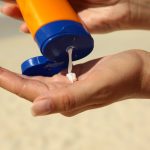Sunscreen WARNING: Here are the most harmful sunscreen ingredients to look out for
 (NaturalHealth365) No doubt, spending time in the sun is beneficial for human health: it’s the best way to ensure your body gets enough vitamin D, and it also promotes a normal sleep-wake cycle. By the way, clinical evidence even shows that UV radiation can destroy the novel coronavirus (although sunlight shouldn’t replace other measures to protect against infectious diseases, like a healthy diet, good sleep habits and other immune-supportive lifestyle habits. But, in terms of sun exposure, you’ll certainly want to consider a good sunscreen to protect your skin from UV damage.
(NaturalHealth365) No doubt, spending time in the sun is beneficial for human health: it’s the best way to ensure your body gets enough vitamin D, and it also promotes a normal sleep-wake cycle. By the way, clinical evidence even shows that UV radiation can destroy the novel coronavirus (although sunlight shouldn’t replace other measures to protect against infectious diseases, like a healthy diet, good sleep habits and other immune-supportive lifestyle habits. But, in terms of sun exposure, you’ll certainly want to consider a good sunscreen to protect your skin from UV damage.
The problem is, most widely available products contain toxic sunscreen ingredients, as noted by the Environmental Working Group (EWG). So, to reduce your environmental toxin exposure, it may be time to upgrade your sunscreen purchase this season.
Read your labels: These are the most harmful chemicals in your sunscreen
From harmful environmental toxins to known endocrine disruptors, these are some of the most worrisome ingredients found in sunscreen products:
- Oxybenzone
- Octinoxate (Octyl methoxycinnamate)
- Homosalate
- Octocrylene
Studies by the U.S. Food and Drug Administration (FDA) and others have detected blood levels of these toxic ingredients well above the cut-off for systemic exposure. Many of these chemicals are also found in human breast milk.
The problem? Evidence suggests these compounds act as hormone disruptors, capable of throwing off levels of important hormones like estrogen, androgen, and progesterone. In addition, according to EWG, oxybenzone has even been associated with altered birth weight in humans.
And this is all just the bad news directly related to human health. Years of data also suggest that toxic sunscreens are destroying coral reefs and other ocean ecosystems.
And now for the good stuff — here are some of the leading natural and non-toxic sunscreen brands on the market, according to experts
For most people, wearing sunscreen matters, even on cloudy days. Here are some of the best non-toxic sunscreen brands for babies, kids, and adults according to EWG:
- Adorable Baby Sunscreen Lotion, SPF 30+
- UV Natural Baby Sunscreen Lotion, SPF 30+
- Thinksport Kids Body & Face Sunscreen Stick, SPF 30+
- 365 Everyday Value Mineral Sunscreen Sport Lotion, SPF 30+
- SunBioLogic Raw Coconut Sunscreen Face & Body Sunscreen Lotion, SPF 30+
While not an exhaustive list, these brands do have many ingredients in common, including zinc oxide.
But keep in mind: According to the Skin Cancer Foundation, sunscreen isn’t always enough for protecting against UV damage, especially if you have sensitive skin or a family history of cancer. Other sun-safe strategies include:
- Seeking shade when possible
- Avoiding direct sun exposure during mid-day (or at least not for more than about 20 to 30 minutes)
- Wearing layered clothing, wide-brimmed hats, and UV-blocking sunglasses
One other thing that could help? Eating a nutrient-dense diet, especially one that’s rich in antioxidants, like selenium. The trace mineral selenium has been shown to protect the skin against oxidative damage and UV radiation.
The upper tolerable limit for selenium is 400 micrograms for teens and adults. According to the National Institutes of Health Office of Dietary Supplements, you can easily meet your recommended daily intake by snacking on a few Brazil nuts, which contain about 68–91 mcg per nut.
And while you shouldn’t eat Brazil nuts or other selenium-rich foods as a replacement for high-quality sunscreen, getting enough of this trace mineral in your diet can be an added source of skin protection.
Sources for this article include:
EWG.org
EWG.org
Wiley.com
NIH.gov
Nationalacademies.org
Skincancer.org
ABCnews.go.com



